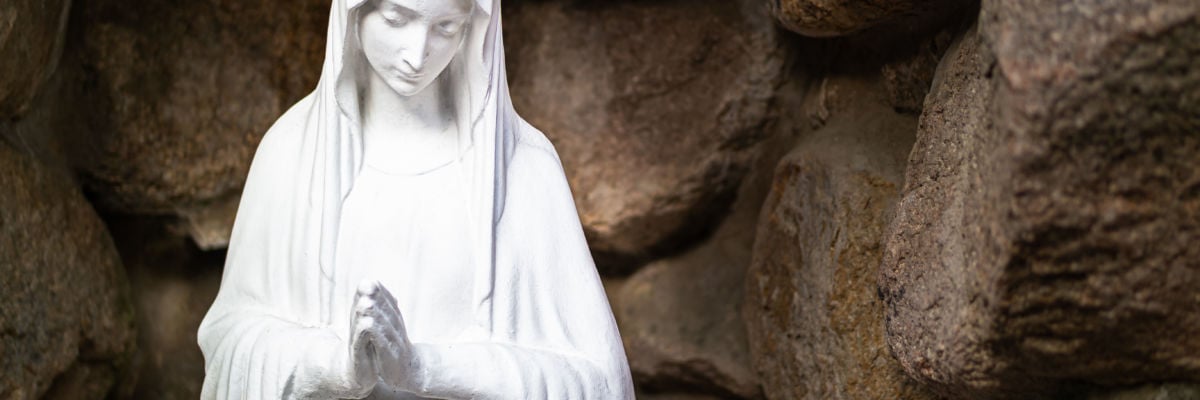
Advent is a time to prepare for Christmas, for the birth of the Messiah, the Immanuel—God with us—the Incarnate Word of God. We celebrate the Immaculate Conception of the Blessed Virgin Mary as the way God prepared Mary to receive the child Jesus on the first Christmas.
The Immaculate Conception is the dogma that says that Mary was conceived without sin. The concepts “without” and “sin” are negative concepts. Sin is the lack of a right relationship with God. This means the statement, “Mary was conceived without sin,” doesn’t say anything positive about Mary. Yet this double-negative could be put into the positive—which is what Scripture does—to say that Mary was conceived with a good, healthy relationship with God. She was conceived as his “highly favored” daughter. In other words, she was conceived “full of grace” (Luke 1:28,30).
Some people object to praising Mary in this way, saying she should not be treated as an exception. Instead, she is just like the rest of us sinful creatures in need of a Messiah. But is Mary the anomaly, or are we?
Consider God’s original plan for man and creation. God conceived the first human beings, Adam and Eve, immaculate, without sin: when God created them, he saw that what he had created was “very good” (Gen. 1:31). They even walked with God in the Garden of Eden. God granted them this grace so that they could fulfill their mission of parents of the human race. He would have granted this grace to all of us had Adam and Eve not sinned. So sin created an anomaly in God’s original plan.
Yet Mary is more blessed than any woman (Luke 1:42). God blessed Mary more than he did Eve, whom he conceived without sin. Therefore, if Mary is truly “blessed among women,” then the New Eve—as early Christians called Mary—was more blessed than the Eve of old. So it shouldn’t surprise us that God prepared Mary to usher in his new creation—Christ (2 Cor. 5:17)—with the loftier mission to be mother of the Messiah. This is the way Scripture paints the full picture of the Virgin Mary, and how God had her conceived without sin and kept her from all sin.
Luke 1:28-30 is the passage most associated with the Immaculate Conception. Here Gabriel calls Mary full of grace or highly favored one. The Greek, Kécharitôméne, is the passive perfect participle form of the verb charitoo, expressing a completed action or definitive perfection. The verb’s root is charis, Greek for grace or favor. The full literal translation of Kécharitôméne would be oh, one who is completely graced or favored. It is followed by “you have found favor [Greek: charis, grace] with God.”
In the fourth century, St. Jerome translated Kécharitôméne as gratia plena—full of grace—since God had blessed Mary “in Christ with every spiritual blessing,” having chosen her in Christ “before the foundation of the world . . . [to] be holy and blameless [Latin: immaculata]” (Eph. 1:3-4).
Light is an image for grace, favor, and righteousness. Christians receive the light at baptism, as “the righteous will shine like the sun in the kingdom of their Father” (Matt. 13:43). God did this with Mary in anticipation of the redemption, of her becoming the Mother of God. He fully favored or graced her in his light, as “God is light and in him is no darkness at all . . . but if we walk in the light, as he is in the light” (1 John 1:5,7). Had the Virgin Mary been tainted by sin, then she would not be fully clothed with the light. She would not be fully favored or graced by God. She would not be Kécharitôméne. God called her “out of darkness into his marvelous light” (1 Pet. 2:9; see also Eph. 5:8).
This fulfilled God’s promise: to pour out his Spirit upon his maidservants and handmaids—upon the handmaid of the Lord, Mary. The Spirit both purified and filled Mary at her conception so she could be called full of grace and most blest of women.
God has chosen all of us “in him before the foundation of the world, that should be holy and immaculate before him” (Eph. 1:4). He wants us to be able to receive the child Jesus on Christmas “holy and immaculate.” So a good way to prepare for Christmas this Advent is to rid ourselves of sin by making a good examination of conscience and then a good confession.
Perhaps it could also be good to identify those areas in our lives where we can improve—triggers that provoke our anger or selfishness. For example, when something is not in the place where we expected it to be, do we get angry and start blaming other people? Perhaps we need to be more detached from our things and realize that they are there to help us serve others and make their lives happier.
Another example is when I am tired and want to rest. Perhaps, in that moment, someone wants my help or needs some attention from me. Do I get irritated and annoyed, and then let it show in my response? Perhaps I need to warn others when I’m tired: “Hey, folks, I’m tired, and you know how any little thing will set me off when I’m this way.” It is amazing that such a “warning,” an act of humility, can strengthen us not to get annoyed and upset when things don’t go our way. Also, if we do lose it, we will be quicker to apologize: “Hey, I’m sorry. It’s not you, but me.” Then everyone can move on and serve one another without resentments!
Let us ask Our Lady, then, to purify us of sin this Advent, through a good confession and by taking steps to distance ourselves from every little thing that leads to sin.



